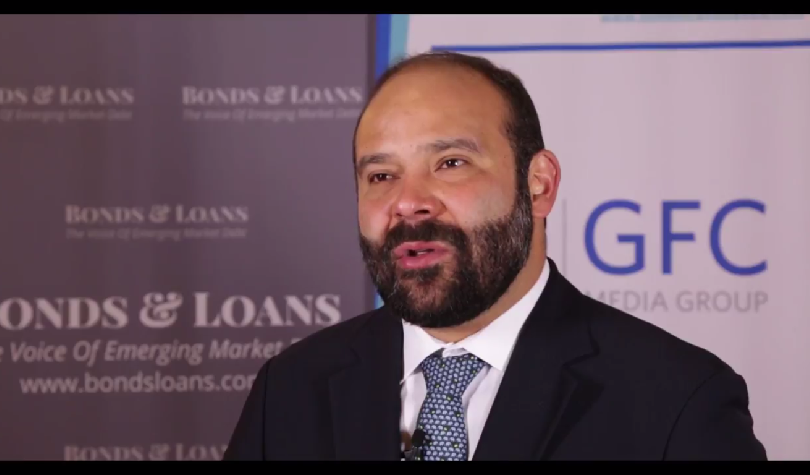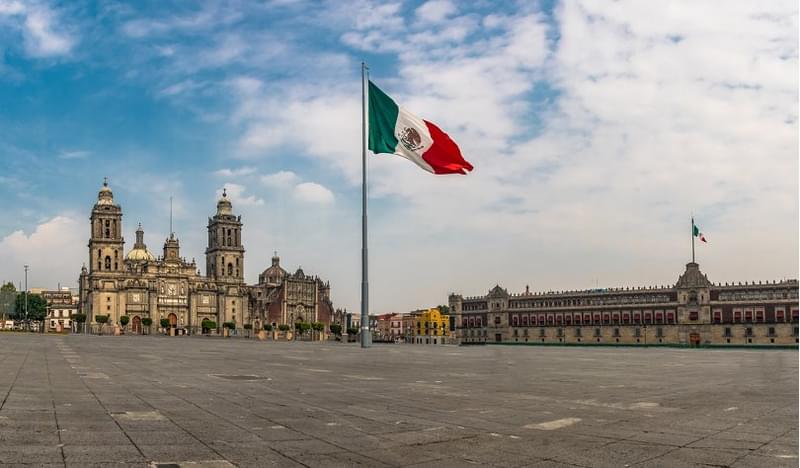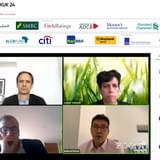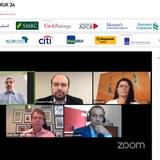Q. Can you give us your assessment of the economic outlook for Mexico in the next 6-12 months? What are some of the most influential factors in play?
A. Mexico has faced shocks in recent years such as the plunge in oil prices, the reduction in the oil platform, volatility in financial markets, and the decrease in the US industrial activity. Despite these shocks, Mexico has experienced a sustained GDP and employment growth, as a result of the structural reforms and the strong economic fundamentals, especially the floating exchange rate regime, a credible monetary policy, and the fiscal consolidation process.
From a perspective of DCM markets, our market is still quite new – our first 10-year bond was issued in 2001, and the first 30-year bond in 2006. Back then, foreign participation in our local currency bonds was pretty low. The financial crisis in 2008 led to more foreign participants coming into the local bond market and now these levels are consistently high. We have four types of local instruments: long-term fixed rate bonds (MBonds, up to a 30-year term), our inflation-linked bonds (Udibonos, up to a 30-year term), the floating rate bonds (Bondes), and zero-coupon bonds for the short part of the curve (Cetes). Since 2008, the foreign investor base of our debt instruments has evolved: initially we saw a lot of hedge fund participation, but since then more resilient foreign investors such as sovereign wealth funds, pension funds and central banks have been coming in. This diversification has been very healthy for our markets. There is also a balanced diversification by region, which helps smooth the rough edges when investor interest drops in one region or another.
For instance, when foreign investors enter the market, they want not only to bet on rates, but also on FX. That includes safe havens like the USD, but also the JPY, among others. In this sense, the Mexican market allows them to have bets both in the interest rate market and in the FX exposure, and this has fostered foreign participation despite the recent FX rate volatility. In this sense, the exchange rate has served well as a shock absorber for the economy; however, this has resulted in more volatility than some of our EM peers. Still, we have not seen FX volatility affecting interest rates –that market has remained quite resilient.
Additionally, our hard-currency debt is still at quite low levels, even when accounting for all the public sector, which includes Pemex and CFE. Pemex has increased its FX debt, but since its contracts provide mostly dollarized income, it mostly needs pesos to pay wages, and therefore it has a natural asset-liability hedge. In recent years, the Federal Government has relied mostly on local currency issues, reducing the external share of the debt portfolio to around 20%, which is considerably low.
 Q. Recently MXP has been hit hard, alongside other EM currencies. CDS hedges have shot up and the sovereign bonds lost 1.3% of value in June. What tools does the government have in store to deal with these challenges?
Q. Recently MXP has been hit hard, alongside other EM currencies. CDS hedges have shot up and the sovereign bonds lost 1.3% of value in June. What tools does the government have in store to deal with these challenges?
A. Several local DCM players have been hedging some of their exposure to the peso –not all of it– using the credit default swaps (CDS). Is it sustainable? I think it is very effective and is quite sustainable –we are not too concerned on this front. It is important to highlight that the MXP is the second most liquid currency among EM, which of course puts some pressure on the peso, compared to other EM currencies that are less liquid, such as the BRL, which foreigners tend to hedge with the MXP. More broadly, the current trend among EM central banks is towards more hawkish policies, so the peso’s dynamic reflects that of many of its peers; just more notorious due to its high liquidity.
Since 2013, as part of preserving healthy public finance and macroeconomic stability, the Federal Government has been implementing a fiscal consolidation strategy that has focused on recovering fiscal space and reducing the public debt as a share of GDP. Last year, the Central Bank of Mexico transferred to the Ministry of Finance its operating surplus generated in 2016 due to the revaluation of the international reserves given the Mexican peso depreciation. In compliance with the Fiscal Responsibility Law, these resources were used to further reduce the public debt, in addition to the targets achieved through broader fiscal discipline. It is worth mentioning that these fiscal targets would have been accomplished regardless of the Central Bank surplus. As a result, in 2016, we succeeded in getting close to 50% of debt as a share of GDP, and in 2017 this share decreased to 46.1%, representing a sharp drop. This year we would like to target a 45.5-45.6% debt to GDP share.
Additionally, the international reserves have reached a historical maximum, as well as our economic stabilisation funds, adding to the Central Bank’s autonomy and its conservative monetary policy; which shows that our fundamentals are proving to be quite resilient.
Q. How significant was this election? Do you expect to see diminishing of political risk for investors post-election?
A. Mexico is currently in a stable situation, although there are always possible risks ahead. In fact, the market has been pricing the future policy events that will follow. That includes the formal appointment of the transition team –a technical team that will work with the Ministry of Finance to plan the economic program for next year. This program consists of the income law that states the deficit target for next year; as well as the budget, which details how resources will be allocated.
The first part has to be approved by a 2/3 majority in Congress in both chambers, while the second part has to be approved by a simple majority in the lower chamber. This is part of the checks and balances established in our Constitution. In this sense, the new administration will collaborate with the current administration on putting together the new economic program, which will be submitted to Congress. In accordance to the law, the economic package must be sent to Congress by December 15, and then Congress will have to approve it by the end of the year. It is important to highlight that Mexico’s institutions remain solid and this helps strengthen the macroeconomic fundamentals.
Q. How are the ongoing, but difficult NAFTA negotiations affecting economic policy outlook? Is there scope to compensate by strengthening ties with Canada, Latin American neighbours or Europe? What other factors will be the driving force in the economy over coming months?
A. The change in the administration is an obvious factor, as well as the composition of the Congress and whether the new administration embraces the continuity of implementing structural reforms, including the energy sector and education. For this matter, several checks and balances exist in our system, especially when it comes to constitutional changes. In addition, rating agencies have warned against any kind of drastic measures.
I have come to the Ministry from Pemex, so I can provide an example from that perspective. Pemex itself does not have much spare money to invest in new projects and ventures, so they are partnering up with foreign companies and investors to share financial burdens and risks. Therefore, it would be harmful for the company to reverse this business model.
So far, the oil field auctions have been successful and transparent, and now we are seeing some progress on the production and exploration side.
As for NAFTA, I must point out that Mexico remains a committed member of the TPP, which has served our country well. In fact, the transition team has not stated any particular qualms about a free market economy, so the negotiations over NAFTA, as well as separate treaties with EU and others, are envisioned to continue in the near future. We will not be building any walls around our economy.
Q. The sovereign has tapped the JPY market this year once again. Japan seems to be an increasingly important trade and investment partner for Mexico, what is behind that dynamic?
A. Japanese investors are very conservative and resilient. For this reason, Mexico (UMS) decided to approach the Japanese investor base under a step-by-step basis. In December 2009, UMS carried out the first transaction in the Samurai market for a total amount of JPY150bn (around USD1.7bn) under the GATE program offered by the Japan Bank for International Cooperation (JBIC), which offered guarantees for up to 95% of the total transaction. Then in October 2010, UMS carried out a second transaction for a total amount of JPY150bn (around USD1.8bn) under that same program. After this transaction, Japanese investors began a more proper and deeper due diligence process regarding Mexico as an investment opportunity. That was when UMS received an A- rating from a JCR, a Japanese rating agency, which was just about the rating needed to access this market on a stand-alone basis.
In terms of debt issuance, one of the main goals of UMS has been to diversify its investor base, not only by type of investor, but also by region. One of the most difficult questions has been: How to internationalize our local bonds? UMS was included in the global bond index by Citibank, which is followed by many Asian investors. As we were going out in search of new investor pools, the Japanese investors were beginning to look for new cross-border opportunities –it was a natural fit.
Since then, UMS has had a regular presence in the Samurai market: in 2012 UMS carried out the first public JPY issuance without any JBIC guarantees –the relationship with JBIC and Japanese investors became stronger, more resilient and full of trust. Because of the negative correlation between the MXP and hard currencies, UMS needs to find an equilibrium for its debt, which is why UMS has worked closely with the Japanese investors to offer the necessary liquidity, issuance sizes and tenors.
Additionally, UMS is continuously providing liquidity to the Samurai market; and it is beginning to see maturities coming through this year from past issuances, so it is refinancing deals from almost 10 years ago. Lately we are also seeing more investors from other Asia Pacific countries (such as Singapore, Hong Kong, and even Australia) participating in Mexico’s samurai bonds, providing further diversification.
In terms of types of investors, UMS started many years ago with hedge funds, but in recent years, there has been an influx of long-term buy-and-hold investors, such as pension funds. In summary, UMS is relying more on its local debt, but also maintaining the drive to have a well-diversified investor base, both in type and geographically.
Q. What are some of the Ministry’s medium-term financing objectives? To what extent is the country looking to raise fresh funding and diversify its funding base?
A. With the most recent JPY issuance, the Federal Government was able to cover completely its external financing needs for this year. Therefore, UMS does not have to seek financing in international markets for now; and because Mexico’s debt is 80/20 local/foreign, UMS is now keen on waiting for a quality window in the international markets, perhaps to refinance some of its external financing needs for the upcoming years.
UMS has access to multiple markets, and it will choose what is most cost-effective. UMS prefers to tap long-term stable markets, such as USD, EUR of JPY. That does not mean we are entirely against new issuances per se, but it is all about the timing and conditions. Since UMS does not need to tap the markets, it has the privilege of being able to wait it out.
Q. How are you encouraging the development of local markets and fixed income assets? Would you look to tap into ESG markets? What other instruments could be attractive to you?
A. Many years ago, when I was still at Nacional Financiera, we became the first Latin American entity to issue a green bond, which was well received by international markets and certified by all the key ESG-related institutions and agencies globally. Since then, the Federal Government has been very active in promoting this market. There are a number of issuers that have placed green bonds, including the new airport (GACM), the Mexico City Government and Banobras, a development bank specialized in infrastructure. Furthermore, Nacional Financiera recently issued a social bond that will finance ESG-compliant projects. In that sense, we are definitely keen to promote these types of deals that create opportunities for issuers and investors. We are also considering other instruments in nascent markets, and we remain attentive to their development.
Q. Who should be getting the price discount on green issuances? Should it be the issuers, or the investors? Should governments subsidise ESG-type instruments?
A. The Federal Government has been working closely with development banks, which have government guarantees, so the levels at which they can issue are well below the private sector capabilities –that is our way of backing these initiatives in a sustainable manner. It is hard to say if there will be actual subsidies from the government in some issuances; however, we provide a structured approach to this market without creating distortions.










